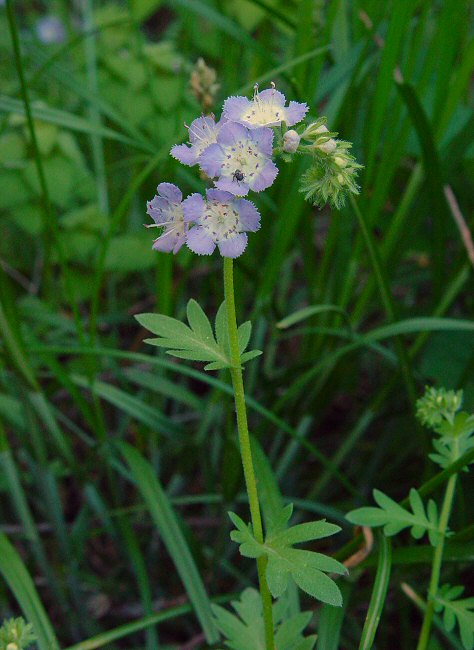Phacelia gilioides Brand
Phacelia

Native
CC = 3
CW = 5
MOC = 50
© DETenaglia
Phacelia gilioides BrandPhacelia | |
 |
Native CC = 3 CW = 5 MOC = 50 |
© DETenaglia |
|
Family - Hydrophyllaceae Habit - Relatively slender annual forb, from a small taproot and fibrous roots. Stems - Mostly strongly ascending to erect from a sometimes spreading base, 10-40 cm long, often few- to several-branched at the base and above, moderately pubescent with stiff, antrorse, nonglandular hairs toward the base, also with moderate to dense, fine, somewhat tangled, nonglandular hairs toward the tip.
Leaves - Basal leaves usually withered at flowering, the blade 1-3 cm long, elliptic to oblong in outline, pinnately compound or deeply lobed with 5-11 divisions, these entire or occasionally with 1 or 2 lobes or coarse teeth (the terminal leaflet or lobe usually 3-lobed), the leaflets or lobes sharply to bluntly pointed or rounded at the tips, the surfaces sparsely to moderately pubescent with more or less appressed, stiff hairs. Stem leaves short-petiolate to sessile and usually clasping, the blade 0.8-5.0 cm long, progressively reduced toward the stem tip, the uppermost leaf blades usually 5- or 7-lobed, the leaflets or lobes bluntly to more commonly sharply pointed at the tips, the terminal lobe of at least the uppermost leaf truncate to slightly angled or tapered at the base, the pubescence similar to that of the basal leaves.
Inflorescence - Terminal scorpoid racemes or cymes with 8-25 flowers, to 10 cm long, compact in flower, quickly elongating in fruit. Pedicels to 1.5 cm long in flower, slightly longer and ascending in fruit, with dense, short, ascending to appressed hairs and sparse to moderate, longer, stiff, spreading hairs.
Flowers - Calyces 4-8 mm long, the 5 lobes with the margins and surfaces pubescent with longer and shorter hairs. Corollas 5-8 mm long, broadly bell-shaped, purple to bluish purple, the margins coarsely and irregularly toothed to fringed, the outer surface finely hairy, especially along the midvein and toward the tip. Stamens 5, not or very slightly exserted, the filaments 4-7 mm long, densely hairy for most of their length. Ovary obconic, with mostly 8 ovules, 1.2 mm long and broad. Style branched to less than or about the midpoint.
Fruits - Capsules 3-4 mm long, the surface not appearing swollen, mostly 6-8-seeded. Seeds 1.5-2.0 mm long, ovoid-angled, finely ridged and/or pitted, dark brown. Flowering - April - June. Habitat - Bottomland and mesic forests, streambanks, fens, bases and ledges of bluffs, prairies, glades, pastures, railroads, roadsides, and open disturbed areas. Origin - Native to the U.S. Lookalikes - P. purshii, P. hirsuta. Other info. - This attractive little species can be found throughout much of the Ozark and Ozark Border region of Missouri, but is apparently absent from most of the northern third of the state. Missouri at at the heart of the plant's natural range, and though it occurs in a few other surrounding states it is considered uncommon everywhere but in Missouri. The plant is easily identified to genus by general appearance, though assignment to species can be a little harder. In general, the corollas are more toothed than those of P. hirsuta but less than those of P. purshii. Since the degree of corolla fringing can be variable even within a species, this character is not completely reliable for species assignment. Another distinguishing feature of P. gilioides is the fine hairiness of the exterior ("backside") of the corolla, which is lacking in P. purshii. Photographs taken in Columbia, MO., 4-15-04 and 4-27-04 (DETenaglia); also at Danville Conservation Area, Montgomery County, MO, 4-28-2016, and Canaan Conservation Area, Gasconade County, MO, 5-5-2016 (SRTurner). |